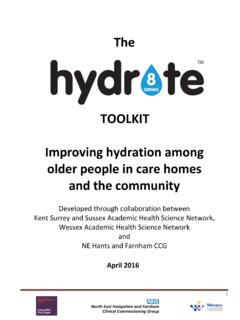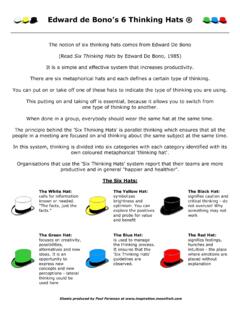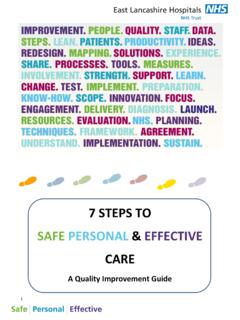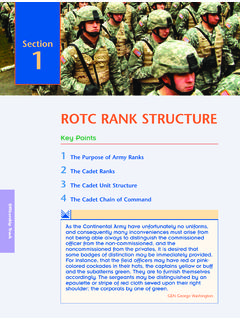Transcription of The Handbook of Quality and Service Improvement Tools
1 The Handbook of Quality and Service Improvement ToolsInstitute for Innovationand Improvement2 The Handbook of Quality and Service Improvement ToolsThe Handbook of Quality and Service Improvement ToolsThe Handbook of Quality and Service Improvement Tools3 The Handbook of Quality and Service Improvement you are involved in treating patients, managing and/or improving health services or managing or training those that do, you will understand the importance of providing the best care possible for all our progress has been made in improving Service standards and access and in reducing waiting times, but there is still some way to go to ensure consistently high standards of patient care across the NHS.
2 It is clear that we need to ensure we are getting it right first time, which means better care and better value through the reduction of waste and errors and the prioritisation of effective treatments. Quality , innovation, productivity and prevention (QIPP) is the mechanism through which we can achieve this. QIPP is about creating an environment in which change and Improvement can flourish; it is about leading differently and in a way that fosters a culture of innovation; and it is about providing staff with the Tools , techniques and support that will enable them to take ownership of improving Quality of Handbook of Quality and Service Improvement Tools from the NHS Institute brings together a collection of proven Tools , theories and techniques to help NHS staff design and implement Quality Improvement projects that do not compromise on the Quality and safety of patient care but rather enhance the patient experience.
3 It is not an exhaustive list and you will find plenty more information on the help and support available from the NHS Institute on our website at But I do hope you will find this Handbook useful as you start your journey towards improving the Quality , productivity and efficiency of services you RA Taylor NHS Institute for Innovation and Improvement4 The Handbook of Quality and Service Improvement ToolsThe Handbook of Quality and Service Improvement ToolsIntroductionThe Handbook of Quality and Service Improvement Tools brings together into a single resource 75 proven Tools , theories and techniques for Quality and Service Improvement .
4 It is part of the Fundamentals for Quality Improvement from the NHS Institute for Innovation and Improvement a suite of publications that will assist you in finding innovative ways to improve the Quality , productivity and efficiency of patient care you provide. You can find out more about all of these publications at All of the Tools , theories and techniques featured in the Handbook and more are available online in our searchable library, available free of charge to the NHS in England at You may find it useful to use the Handbook in conjunction with the Step-by-Step Guide to Tackling your Challenges, which maps some of the key challenges you have told us the health Service is facing against a range of Quality and Improvement Tools and products developed by the NHS Institute to support the NHS in improving the Quality .
5 Productivity and efficiency of services. This guide is available in hard copy and as an interactive PDF via the website at to use The Handbook of Quality and Service Improvement ToolsThe Handbook is divided into the following two sections:Section one: Project management guideThis step-by-step guide provides a suggested framework that will enable you to systematically progress through a Quality and Service Improvement project. Each organisation is different and you may find that the stages described here are slightly different to the project management guide you are familiar with. However, there should be enough similarities between the two for you to match the stages outlined in this guide against those in your preferred framework for project management.
6 The Handbook of Quality and Service Improvement Tools5 The Handbook of Quality and Service Improvement two: Quality and Service Improvement Tools In this section you will find a comprehensive set of Tools , theories and techniques that will enable you to expand your knowledge of tried-and-tested Tools and techniques for improving Quality and Tools have been grouped under the following headings, which relate to the type of task you may be addressing:1. Project management2. Identifying problems3. Stakeholder and user involvement4. Mapping the process5. Measurement for improvement6. Demand and capacity management7.
7 thinking creatively8. Human dimensions of change. Text highlighted in blue throughout the Handbook indicates additional Tools that will help you with your Service Improvement efforts. An A-Z index can be found at the back of the Handbook to help you quickly find any additional Tools you may need for the task in hand. The Handbook for Quality and Service Improvement Tools will be helpful for both clinical and operational staff involved in Quality and Service Improvement /transformation. 6 The Handbook of Quality and Service Improvement ToolsThe Handbook of Quality and Service Improvement ToolsSecTion 1 Project management guide.
8 8 SecTion 21 Project Scope your project .. Four columns: link your project to the organisation s aims .. Benefits realisation .. Action planning .. Responsibility charting .. Sustaining momentum .. Reviving a stalled effort .. Learning from change ..382 Identifing problems .. Using an affinity diagram .. Cause and effect (fishbone) .. Root cause analysis using five whys .. Data check sheet (frequency plot check sheet) .. Pareto .. Histogram (frequency plot) .. Scatter diagram (correlation) .. Identifying frustrating problems ..663 Stakeholder and user involvement .. Stakeholder analysis.
9 Communications matrix .. Patient perspectives .. Staff perceptions .. Clinical engagement (in an acute setting) ..914 Mapping the process .. Conventional process mapping .. Value stream mapping .. Spaghetti diagram .. Mapping the last ten patients .. Process templates .. Tracer study .. Sort and shine ..1325 Measurement for Improvement .. Performance management and balanced The model for Improvement and plan, do, study, act (PDSA) .. Performance measures sheet .. Managing variation .. Statistical process control (SPC) .. Methodology for measuring benefits .. Modelling and simulation.
10 172 ContentsPageThe Handbook of Quality and Service Improvement Tools7 The Handbook of Quality and Service Improvement Demand and capacity management .. Demand and capacity a comprehensive guide .. Theory of constraints .. Flow reduce unnecessary waits .. See and treat patients in order .. Clinically prioritise and treat .. Glenday Sieve (runners, repeaters, strangers) .. Reliable design .. Role redesign .. Lean Ohno s eight wastes .. Reducing cancelled operations .. Reducing did not attends (DNAs) .. Reducing length of stay .. Discharge planning .. Day surgery treat day surgery as a norm.








